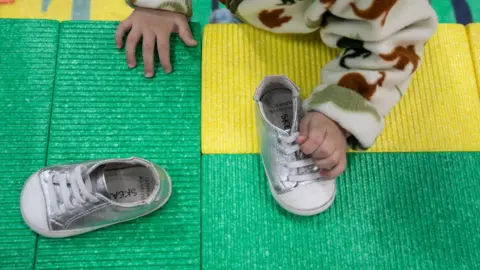
South Korea is the most birth rate in the world, but breeding clinics are getting rich
BBC News

 Getty
GettyWhen she started the Vitro Fertilization (IVF) last November, Kim I knew that this would be a terrible test of courage – three years ago when she had tolerated her first child.
But what shocked her at this time was the “crazy” breeding clinic stopped.
“When I went in January, it seemed that everyone had made a New Year’s resolution to be a child! I waited for three hours with reservation,” 36 -year -old Soul residents say.
While South Korea is struggling with the world’s lowest birth rate, there is an increasing demand in the fertility clinic – a brilliant place in the country’s population crisis.
From 2018 to 2022, the number of breeding treatment in the country increased from about 50% to 200,000. Last year, one of the six babies in Soul was born with the help of breeding treatment.
Underline the boom, experts say that the outlook on family planning is to change.
Sarah Harper CBE, a professor of Jerrantology of Oxford University, says, “We have a younger generation … which is the habit of controlling his life.” It adds, this control can come into the form of couples who are trying to get pregnant with women’s eggs or couples alone.
“In the past generations, more agreed to whether you pregnant or not, it can be a bit annoying, now we are saying Korean women,” I want to plan my life. “”

 Getty
GettyThis is good news for the South Korean government, who is trying to raise the country from a democratic crisis. One of the five people in South Korea is now 65 or more. As the total population of the country, there were never fewer babies.
The lowest birth rate in the world in 2018: The lowest rate in the world: The country has repeatedly broke its own record: in 2018, 7.9 Babbes baby in 2018, 7.8484 in 2 and 523. If this trend continues, experts warned that the million population could decrease in the year of 5 million years.
But recently the cause of cautious optimism: South Korea’s birth rate rather than the second second has increased slightly in 2024.
The School of Professor of Management and Management of the Korea Development Institute says, “This is a small blow, but still a meaningful.”
It is very early to say whether this is a very essential reverse or just a single bliss start. The birth rate of the country is much lower than the global average of 5.5. But Dr. Many people like Choi are careful with caution.
“If this is a trend, it can indicate a long -term shift,” says Dr. Choi. “We need to see how young people are changing towards marriage and parenting.”
Bump
For many years, it was the last thing that had children in the mind of India. She was mostly busy with the work, often just closed at 04:00 pm from her advertising job.
“I was in a company with endless overtime, so there was nothing I could really think,” said a 35 -year -old boy.
Two years ago, when she got married, things started to change. She got a new job with good hours – and the friends around her started the baby.
She said, “Looking at them with their children and interacting with them began to feel less tremendous,” she said. “And my new Husband took the initiative, researching pregnancy and childbirth, and by showing real effort, we have confidence that we can do this.”
When Ms. Park and her new Husband were in trouble to get pregnant, they looked at the breeding treatment. Many people are doing this by fueling estimates that can be worth more than $ 2 billion in the growing industry by 2030.
Jennifer Sibaba, the president and chief executive officer of the Nanafa Profit Population Bureau in Washington, DC, says, “It is a really important signal for policymakers that there are still some women who want to start families but they have to deal with….”
“Most importantly, this is the sign that people are unable to wish you the desire of children.”

 Jung sa-rryon
Jung sa-rryonThe problem of pregnancy is just a barrier. There is a complaint of social and economic pressure in the middle of the population of South Korea – from male -dominated standards who take care of most children on women Long work hours and Higher Education Cost – which prevents many young people from becoming children.
For some, however, those dreams are just late. According to a UN report, more than half South Korea says they want children but they cannot afford it. And when South Korean women were the first child, their average age is 33.6 – one of the world’s highest people.
“Looking back, it may have been good to start before,” says Ms. Park. “But in reality … now it really seems to be the right time. In my 20th decade, I didn’t have the financial ability to think about marriage or children.”
This is the same for Ms. Kim, who spent three years for marriage and four more years for the child.
“People spend money on their youth, hiring jobs and preparation for life. And it is often late when they are ready to settle,” she says. “But then you stop, it was more difficult Pregnant), physical and emotional. “
Obstacles on the road
The process of pregnancy is also more expensive for those who choose IVF.
“It is difficult to say how much IVF is worth because it changes a lot through the person and the bicycle,” says Ms. Kim. “This is a huge and unpredictable cost that can really affect our financials.”
As part of a combined effort to boost his birth rate, the South Korean government has increased its support for breeding treatment. Soul now won 2 million Korean Won ($ 1,460; £ 1,100) and 1.1 million for each IVF treatment for egg-freezing.
But even with government grants, Ms. Kim says she spent spending 2 million won in January for IVF-mainly supplemented pockets, such as supplements and additional tests.
And with Less than half IVF cycles that end in success, The costs can quickly stack.
The incident of Jung Sa-Rio in the southwestern Jiola province has happened. The 37 -year -old boy started reproductive treatment two years ago and has five IVF cycles, each of which cost approximately 9. Million has won millions.

 Jung sa-rryon
Jung sa-rryonShe said, “I want things to be completed after only one or two attempts, but not for most people,” she says. “Without money, you can not just go ahead. It is a reality. And I think this is the most frustrating part.”
According to women, equally challenging, when they are committed to the demand for IVF, they have to deal with them.
South Korea companies offer several days for breeding, while women say they are actually difficult to use. Ms. Kim says she did IVF for her first child without leave. In the meantime, Ms. Jung says that her colleagues asked her to postpone her treatment.
“It felt I felt IVF and does not mix a full -time job,” says Ms. Jung. “So I left. But once I left, I struggled financially. This led to another cycle of leaving again and doing a job-governing.”
Such economic and cultural pressure may have dreamed of having many dreams of South Korea’s dreams, but not Ms. Jung. When she remembered two pregnancies from the beginning of her marriage, she was still weak – both of which had an abortion.
“When you have a child, you know how they say, you feel loved that is infinite?” She says. “I think it is a great form of joy that a person has to feel like a child like both of you and creating a family together.”












Post Comment